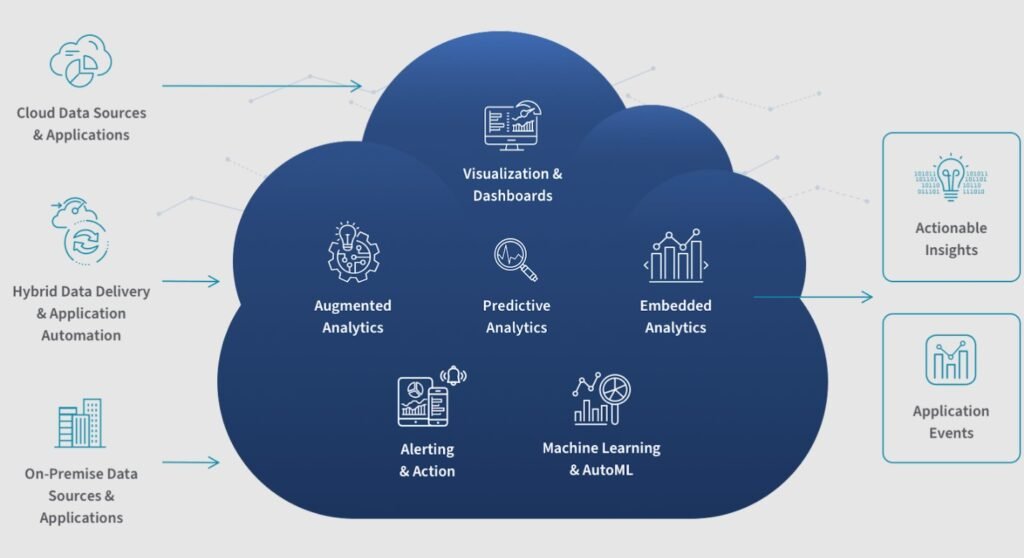In the past, businesses invested heavily in on-premises infrastructure to manage their analytics needs. Rows of servers, bulky storage systems, and dedicated IT teams were once the backbone of data-driven decision-making. But the technology landscape has shifted dramatically. With the rise of cloud-native analytics, on-premises solutions are rapidly losing ground. Companies now seek agility, efficiency, and scalability—qualities that the cloud delivers far better than traditional infrastructure.
The Shift Towards Cloud-Native Analytics
Cloud-native analytics refers to the practice of designing and running data analytics applications directly within cloud environments. Unlike legacy systems that were retrofitted for online access, cloud-native platforms are purpose-built to take advantage of distributed computing, elastic scalability, and managed services.
This approach enables organisations to move away from rigid, capital-heavy infrastructure towards flexible systems that grow or shrink in line with demand. Whether it’s analysing customer behaviour, forecasting supply chain needs, or applying machine learning to large datasets, cloud-native tools make the process faster and more cost-effective.
Why On-Prem is Losing Relevance
The decline of on-premises analytics can be traced to several overlapping factors:
1. High Maintenance Costs
Running an on-prem data centre involves ongoing expenses: hardware purchases, cooling systems, physical space, and skilled personnel to manage the infrastructure. These costs often exceed the predictable, subscription-based pricing of cloud platforms.
2. Scalability Limits
On-prem systems have fixed capacity. If workloads suddenly spike—say, during a product launch or holiday season—companies may struggle to handle the demand. Cloud-native analytics allows instant scaling, both upwards and downwards, ensuring resources are optimised.
3. Delayed Innovation
Rolling out new analytics capabilities on-prem can take months, as teams procure equipment, configure servers, and integrate software. Cloud-native solutions, by contrast, provide ready-to-use services such as data warehouses, AI-powered analytics, and real-time dashboards that accelerate innovation.
4. Remote Work Dynamics
The global shift towards hybrid and remote working has amplified the weaknesses of on-prem systems. Employees need seamless access to analytics tools regardless of location. Cloud-native platforms deliver this flexibility, supporting collaboration without dependence on physical infrastructure.
5. Security & Compliance Evolution
While many once viewed on-prem as more secure, this perception is changing. Major cloud providers now offer advanced encryption, automated compliance reporting, and built-in disaster recovery, often at levels unattainable for individual enterprises.
Cloud-Native Advantages That Stand Out
Beyond replacing what on-prem could do, cloud-native analytics adds capabilities that were previously unimaginable:
- Real-time insights: Cloud platforms support continuous data pipelines, enabling businesses to act on insights instantly.
- Integration with AI and ML: Training and deploying machine learning models is significantly easier with managed cloud services.
- Cost transparency: Pay-as-you-go pricing ensures companies only spend on what they use, avoiding the sunk costs of idle hardware.
- Innovation ecosystem: Cloud providers frequently roll out cutting-edge tools—from natural language query systems to automated feature engineering—keeping businesses at the forefront of analytics.
The Human Side: Upskilling for Cloud Analytics
As the technology shifts, so must the skills of professionals. Moving from on-prem to cloud-native analytics requires knowledge of cloud platforms, distributed computing, and modern data architectures. Organisations increasingly invest in reskilling initiatives to prepare employees for this transition.
For individuals, the demand for cloud-savvy data professionals represents an enormous career opportunity. Those enrolling in specialised programmes, such as data analytics courses in Delhi NCR, gain exposure to cloud-based tools and practical case studies that reflect today’s industry needs. By learning how to design, manage, and interpret analytics in the cloud, professionals position themselves at the forefront.
Real-World Applications
Many industries are already proving the value of cloud-native analytics:
- Retail: Brands use cloud analytics to track customer behaviour in real time, adjusting promotions and inventory dynamically.
- Healthcare: Hospitals leverage cloud-native platforms for predictive modelling, helping allocate resources and improve patient outcomes.
- Finance: Banks rely on the cloud to process millions of transactions per second while monitoring for fraud in real time.
- Manufacturing: Cloud analytics allows predictive maintenance, reducing costly downtime by identifying machine failures before they occur.
Each of these examples shows that cloud-native is not just an IT trend but a fundamental enabler of business competitiveness.
The Road Ahead
As organisations continue to generate vast volumes of data, reliance on cloud-native analytics will only deepen. Analysts predict that within a few years, on-prem systems will be reserved for niche use cases such as highly sensitive government projects or industries with unique regulatory demands. For the majority, cloud will become the default.
For professionals, this means now is the right time to build expertise in cloud-driven analytics. Upskilling through recognised programmes, like data analytics courses in Delhi NCR, ensures not just career relevance but also the ability to contribute meaningfully to the digital transformation of industries.
Conclusion
The message is clear: on-prem is fading fast, and cloud-native analytics is rising as the future. The advantages in scalability, cost-effectiveness, innovation, and accessibility make the cloud the natural choice for businesses aiming to stay competitive. For professionals and organisations alike, adapting to this new reality is not optional—it’s the only way forward.
